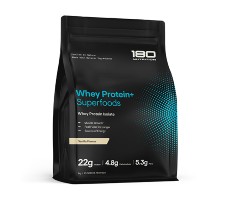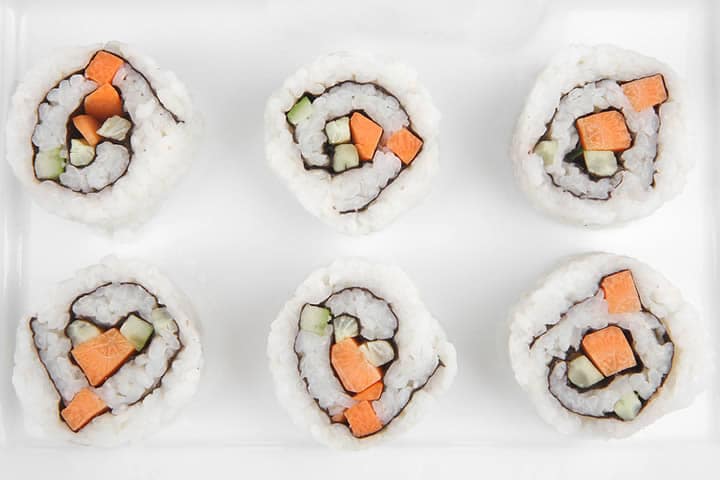Angela: Is sushi healthy or not? Hmmm… there is quite a lot to consider. For me there’s the Japanese food I would eat for a quick and semi-healthy lunch on the run and then there’s the Japanese dinner when I relax with friends and don’t stress too much about what is being ordered. What I take into consideration for the semi-healthy lunch on the run:
- Sushi rice is made with sugar and rice vinegar (on average 2 tbsp of sugar and 2 tbsp of rice vinegar per 2 cups of rice). Typical sushi hand rolls are 60 – 75% rice and the equivalent carb content of two slices of bread.
- The type of rice used in sushi is short grain rice which spikes blood sugar levels.
- The protein amounts in sushi are very small – I recommend a palm size of protein with every meal. You would have to eat a lot of sushi to get that covered and then there’s all that rice you would eat along with it.
- As it’s low in protein and fat it’s low in satiety and you will be craving more sugar after lunch.
- I would avoid processed protein like crab sticks, anything fried as it would most likely have been fried in vegetable oil and anything with teriyaki sauce (full of sugar). I generally opt for things like fresh salmon, tuna or kingfish.
- Avoid Teriyaki sauce and Japanese mayo they are very high in sugar
- Seaweed salads – I have them depending on the establishment. Most places don’t make them on the premises and will be commercially made and will more than likely have added MSG.
- Avoid Tempura – they will be fried in vegetable oil. What you need to know when selecting cooking oils.
- Edamame (soybeans) – I will eat soybeans in their whole form from time to time but I do avoid all refined soy products (tofu, soy oil, soy milk). 90% of soy products are genetically modified in the US. There is a big debate on whether soy is a healthy food, there are lots of studies supporting both sides of the argument. My number 1 concern is that they contain natural plant oestrogens that mimic estrogen in our bodies and may cause hormonal imbalances. I would avoid if you are trying for a baby, pregnant or have any endocrine issues.
- It’s very salty – the sushi rice is made with salt and soy sauce is very high in salt. If you are on a low salt diet one to avoid.
- Soy sauce contains wheat – If you are wheat intolerant like me you can have Tamari which is a wheat free version of soy sauce.
When eating sushi I follow these rules:
- I take my own bottle of Tamari… I know – a little sad! I do it if it’s a planned dinner date… no one ever cares or blinks an eye lid
- Stick to sashimi
- Ask for my rolls to be rolled without rice (depends on the establishment)
- If having rice, I go for brown
- If white rice rolls are the only option I take some of the rice off
- Protein sources: I go for things like raw salmon and tuna
- I go somewhere that I know they have a high turnover so I know it’s fresh
- Have a seaweed salad if you think it’s MSG free. Seaweed is a good source of vitamins and mineral, protein and fibre
Conclusion:
If you are not careful sushi can be a very high carb lunch without any protein or vegetables leaving you hungry and craving more sugar after lunch.
Are you struggling for healthy snacks and quick meal replacement options? Check out 180 Natural Protein. Sugar and chemical free with 100% natural ingredients.





3 Replies to “Don’t Make These Mistakes When Choosing Sushi”
Isn’t pickled ginger full of high fructose corn syrup too? I avoid it all now. I’m better without the sugar.
I only go for the fresh ginger when available. Angela 🙂
Several of the points in this article are quite sensible (e.g., about the low protein content and high carbohydrate content of sushi). But there are a couple of areas where your points are not in line with the empirical evidence.
1. MSG is perfectly safe (see http://jn.nutrition.org/content/130/4/1049S.short for a review). The idea that it’s some kind of dangerous additive is basically just an urban myth that has never been supported in the academic literature (aside from a couple of opinion articles in obscure non-medical journals).
2. In terms of the safety of soy, you recognise the presence of a debate, but then rapidly take one side of that debate without really presenting any evidence. In this case the picture is not quite as definitive as for MSG, but overall the safety of soy is well supported. See http://onlinelibrary.wiley.com/doi/10.1301/nr.2003.janr.1-33/abstract
In general it’s a good idea to try and read the *peer-reviewed* literature on topics such as food additives, rather than relying on information found in blogs, newspaper articles, forums etc. A good way to do this is to go to http://www.scholar.google.com and type in the name of the topic you’re interested in, followed by the word “review”. This will lead you to review articles that give you a summary of the peer-reviewed literature on the topic.
Comments are closed.